You can’t successfully can horseradish sauce at home for shelf-stable storage. The volatile oils in horseradish that give it its kick are destroyed by heat.
You can however make horseradish sauce for cold storage — either refrigerator or freezer.
The recipe
Jars: As this is not a canning recipe per se, you may use any size jar you want. The recipe suggests ¼ litre (½ US pint / 8 oz) jars. The jars will need lids. As this is for refrigerated storage, this is where you could use antique jars (that still close properly) or Le Parfait jars, etc.
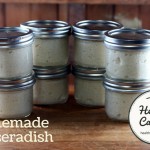
Homemade horseradish
Ingredients
- 350 g horseradish root (grated. ¾ lb / 2 cups)
- 250 ml white vinegar (5% strength or higher)
- ½ teaspoon salt (OR non-bitter, non-clouding salt sub)
- ½ teaspoon lemon juice (optional. OR ¼ teaspoon ascorbic acid.)
- sugar (white. to taste. Optional)
Instructions
- Wash horseradish roots and peel.
- Grate the roots.
- Mix all ingredients together and pack into clean sterlized jars.
- Screw lids on jars tightly.
- Store in refrigerator.
Notes
Nutrition
Reference information
Australia and New Zealand vinegar strength special notes.
Recipe notes
You may use any type of vinegar you wish. You could use apple cider vinegar, though that would of course impact the colour and darken the horseradish mixture. Or you could try a white wine vinegar. The USDA, from where this recipe comes, does specify 5 % acidity, so presumably that specification is there for a reason even though this is refrigerated, not canned.
A bit of sweetener can help to round the taste out. We’ve suggested white sugar; you could try Splenda or a few drops of liquid stevia. For stevia, we’d recommend Better Stevia liquid stevia .
You could use a salt sub instead of salt; we’d recommend Herbamare Sodium-Free .
The lemon juice / ascorbic acid (aka Vitamin C powder) is there to prevent darkening. Ascorbic acid does a better job of doing this while not impacting flavour, but we put lemon juice first as an ingredient as more people are likely to have it to hand.
The USDA, from where this recipe comes, does not give a suggested storage life in the fridge. But Linda Ziedrich who gives a variation of this recipe (see Recipe source) says, “The horseradish will keep well for about a month.”
Recipe source
Pickled Horseradish Sauce. In: United States Department of Agriculture (USDA). Complete guide to home canning. Agriculture information bulletin No. 539. 2015. Page 6-30.
Also consulted:
- Pickled Horsradish. In: Ball Blue Book. Muncie, Indiana: Healthmark LLC / Jarden Home Brands. Edition 37. 2014. Page 152.
- Prepared Horseradish. In: Ziedrich, Linda. The Joy of Pickling. Boston, Massachusetts: The Harvard Common Press. 2009. Page 363.
Modifications made:
- Put lemon juice because lemon juice is more common and turned ascorbic acid into an option as per Linda Ziedrich;
- Added Ziedrich’s suggestion of a bit of sweetness “to smooth the flavour”.
Nutrition information
Serving size: 1 tablespoon
Per 1 tablespoon: 9 calories, 0 mg sodium
Weight Watchers PointsPlus®: 1 to 2 tablespoons, 0 points; 3 to 6 tablespoons, 1 point.
* Nutrition info provided by https://caloriecount.about.com
* PointsPlus™ calculated by healthycanning.com. Not endorsed by Weight Watchers® International, Inc, which is the owner of the PointsPlus® registered trademark.
* Better Stevia ® is a registered trademark of the NOW Foods Company.
* Herbamare ® is a registered trademark of the A. Vogel Corporation.
Comparison of ways to grate horseradish roots
We compared four ways to grate horseradish roots and these were the results:
- Food processor: purée;
- Food mill: stringy like shredded cheese;
- Blender: square little chunks;
- Hand-grater: perfect consistency
The hand grater proved the best way.
Here are the visual results.
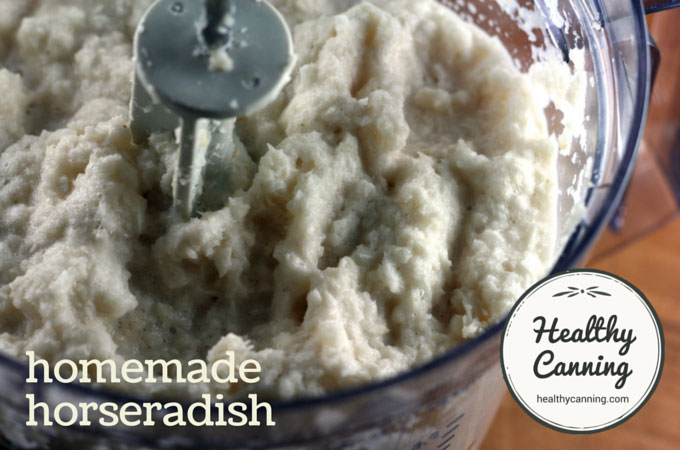
Food processor: purée
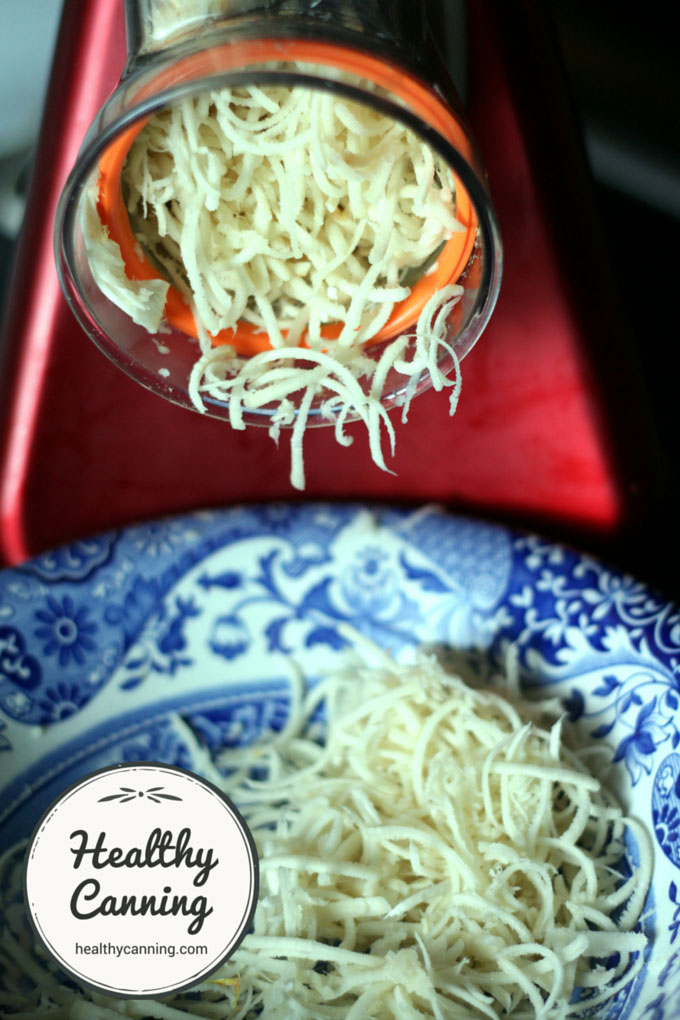
Food mill: like shredded cheese
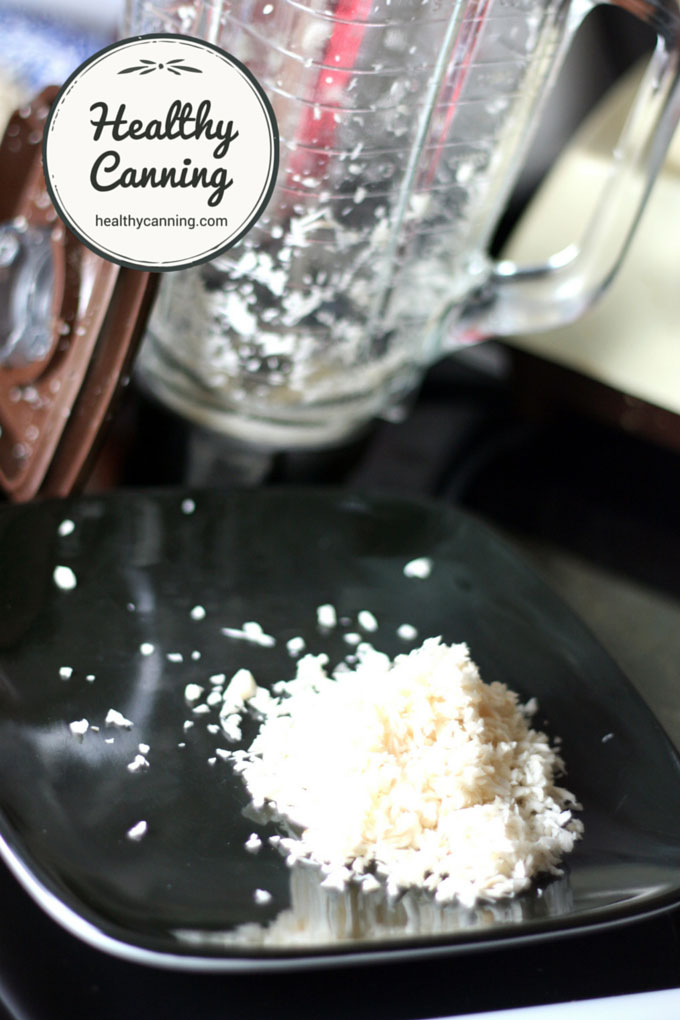
Blender: small chunks
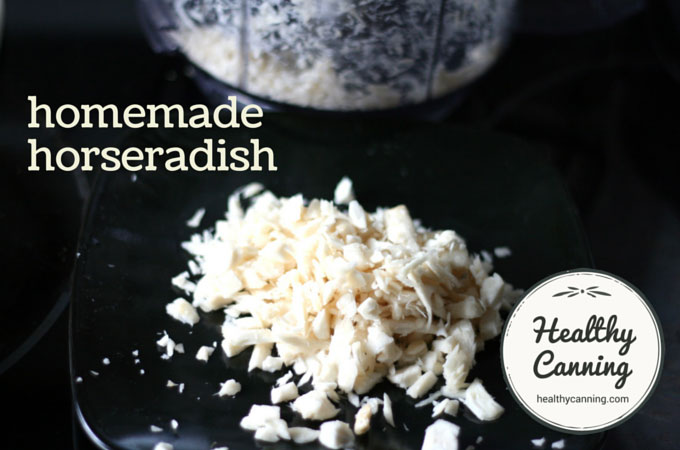
A better close-up of the blender chunks
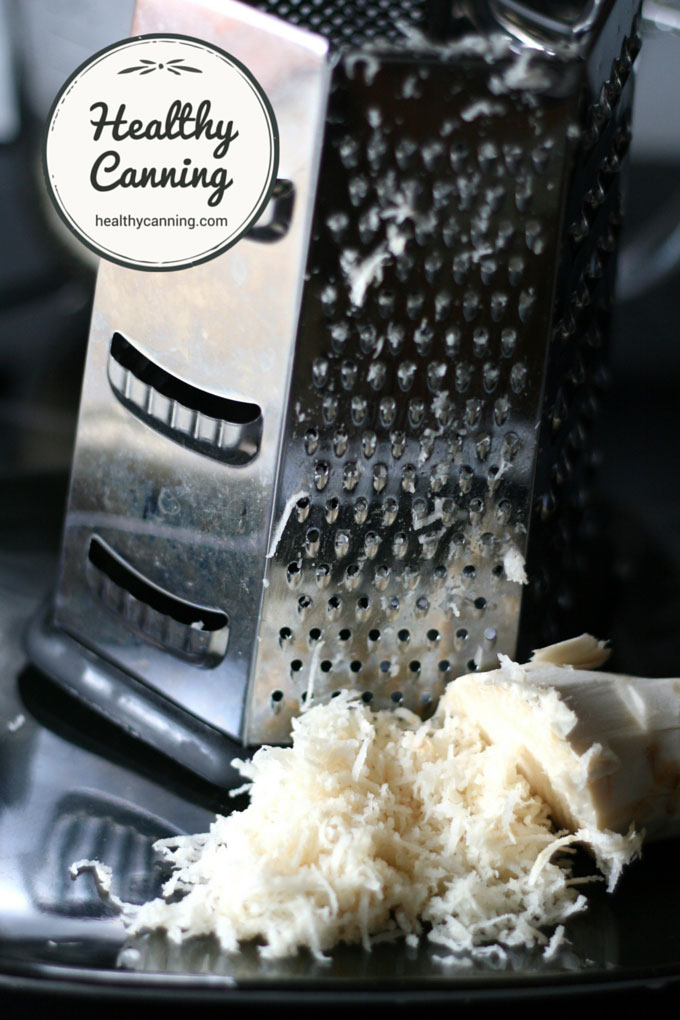
Hand-grater: just about the consistency you’d expect. So the old manual method wins.
Tips for making horseradish sauce
According to the University of Minnesota Extension, the longer you let the horseradish sit grated before adding the vinegar, the hotter it will get, up to about 3 minutes. At that point, it will have hit maximum hotness, if that is what you are after, and you add the vinegar. [1] Herman, Marilyn. Making Horseradish. University of Minnesota Extension. 2001. Accessed March 2015 at https://www.extension.umn.edu/food/food-safety/preserving/vegetables-herbs/making-horseradish. It won’t get any hotter after 3 minutes.
How strong it was to start with will depend on the freshness of the roots. If you purchased the roots from a grocery store, then all bets are off for how long the roots were in a cold-storage warehouse before being trucked to distributors.
Horseradish will lose its hotness in the fridge. It will still be somewhat hot after a month, milder after two months, and quite mild after three months.
It will also darken in storage in the refrigerator.
A little sweetener such as stevia can help to smooth the flavour; a bit of ascorbic acid (or Ball Fruit-Fresh Produce Protector) can help alleviate the browning.
Don’t necessarily expect to save any money by making your own, if you are buying the roots. The roots can be expensive to buy, so count yourself lucky if you break even on making your own from purchased roots versus buying prepared bottles. The taste of homemade, though, is better than store bought, as you would expect, so you will be ahead that way, and the store-bought can be very high in added sodium.
You can freeze jars of homemade horseradish in the freezer (in straight-edged, freezer-safe jars, or plastic tubs.)
Some people note that the Japanese successfully make dried horseradish powder (wasabi powder). The University of Minnesota’s extension service, however, says it’s not worth trying to dry or dehydrate horseradish. “Drying will not produce a successful product.” [2]Herman, Marilyn. Making Horseradish. They do not say in which regard.
If you want a creamed horseradish sauce, stir some double-cream or sour cream into the prepared horseradish sauce when serving.
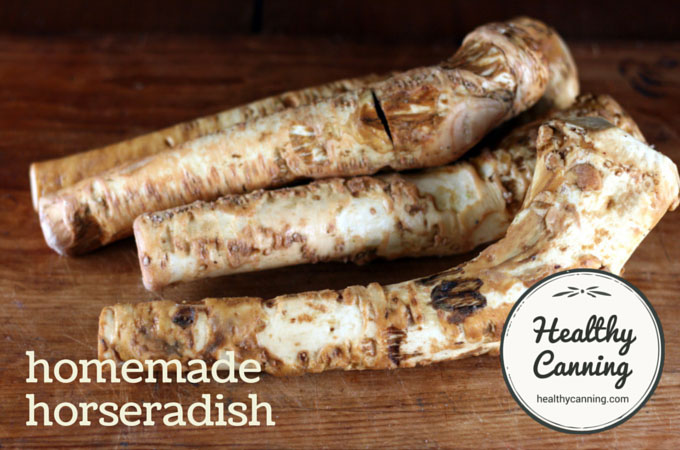
Horseradish root before being peeled.
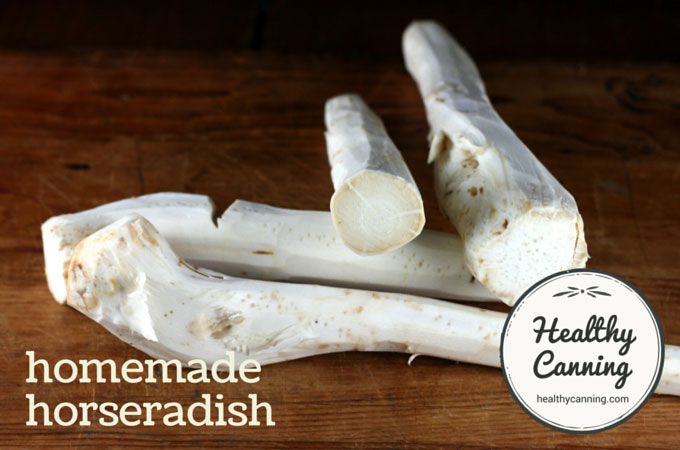
Horseradish root after being peeled.
Horseradish’s role in canning
The FDAs table of “Approximate pH of Foods and Food Products” assigns a pH value of 5.35 to freshly ground horseradish [3] FDA. Center for Food Safety and Applied Nutrition. Acidified and Low-Acid Canned Foods. April 2007. Accessed March 2015 at https://www.foodscience.caes.uga.edu/extension/documents/fdaapproximatephoffoodslacf-phs.pdf. so it counts as a low-acid ingredient on its own, not made into a pickled sauce.
Some old-timers think that horseradish can play a firming role, but the jury is out on that still. Linda Ziedrich says,
Horseradish is not only a traditional pickle flavoring, it’s also said to be a firming agent. From my limited trials, I suspect that horseradish may help prevent the softening of fermenting pickles by inhibiting yeast growth. The fresh pickles I made with horseradish, however, were noticeably softer than those I made with alum, grape leaves, and our cherry leaves. Unfortunately, it seems that no scientist has done a proper study of horseradish in pickling. So I suggest using abundant amounts of grated or chopped horseradish with fermenting cucumbers to see what happens (let me know!), but none at all with fresh pickles unless you happen to like the mustardy flavor.” [4]Ziedrich, Joy of Pickling, Page 18
Many pickle, relish and chutney recipes, etc, call for the addition of horseradish to add some heat and kick to the recipe, presumably. The problem is, the heat of horseradish cannot withstand — heat. The late Alan Davidson, author of the Penguin Companion to Food wrote:
The pungent odour and hot taste of horseradish are due to a substance called sinigrin which, when it is decomposed by the action of enzymes, liberates a volatile oil, similar to mustard oil, containing sulphur. The release of these properties only occurs when the root is cut or bruised, an unbroken root has no smell…. Horseradish sauces are usually uncooked or only gently warmed. Heat destroys the pungency, and when whole horseradish roots are cooked as a vegetable, which they occasionally are in Eastern Europe, the flavour is quite mild.” [5] Davidson, Alan. The Penguin Companion to Food. London: The Penguin Group, 2002. page 464.
So while some flavour of the horseradish may come through, little to no “kick” or “pungency” actually will.
In the classic French sauce, “Albert Sauce“, horseradish is boiled for 20 minutes. The sauce ends up with a horseradish background taste, but not the pungency or heat.
Ziedrich appears to imply that horseradish may have slight preservative properties — “Like mustard oil, horseradish cointains the pungent chemical allyl isothioyanate, which has been proven to kill food pathogens.” [6]Ziedrich, page 363. But pursuing that line of thinking or the science behind it is beyond the scope of this page at this time.
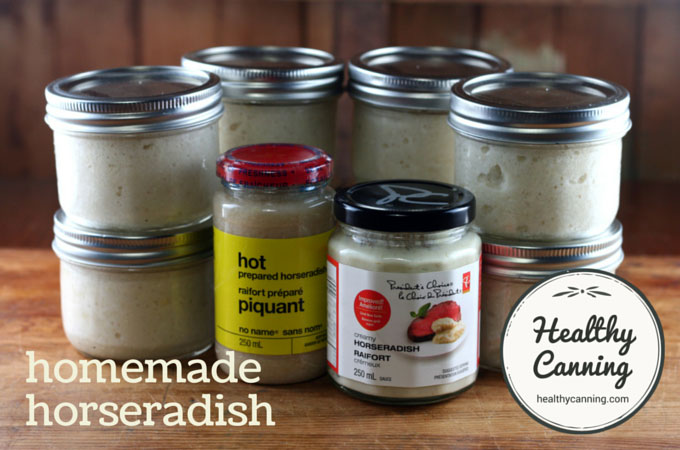
You won’t necessarily save any money compared to store-bought horseradish, but, the homemade is delicious, and, it doesn’t have all the salt that is added to the store-bought versions.
References

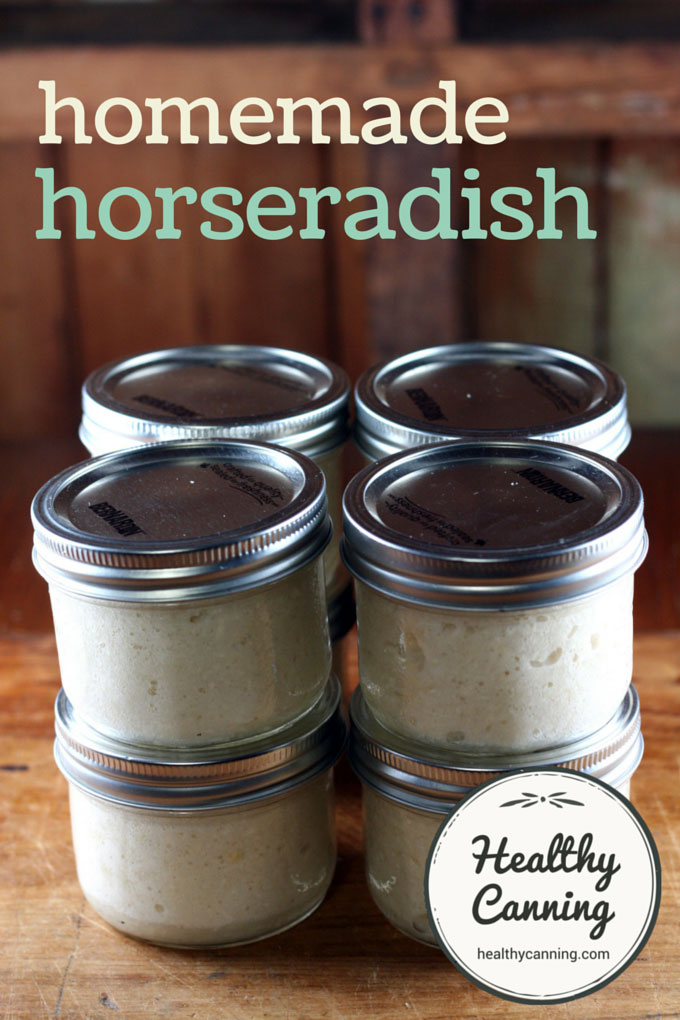
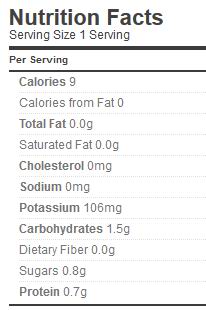
Elbert Jones
Be careful about using a blender to grind up your horseradish root. It will give your blender pitcher a distinct odor. One that might be impossible to remove.
you might want to get a used blender to do it. Incase you own an expensive blender.
Cindy Thoenes
I had a lot of horseradish to process so I used the food mill attachment for my kitchenaid mixer to make the shreds and then put the shreds in the food processor. When done this way you get tiny shreds similar to the results of a hand box grater but a lot less work!
Deborah Johnson
My parents always told me you should harvest horseradish root in any month ending with an “R”
Polly
Have you made this recipe with apple cider vinegar?
What is the shelf life in the fridge? Thanks!
Healthy Canning
Apple cider vinegar would be fine though it could discolour the horseradish. The shelf life in the fridge is about a month.
Patricia Habbyshaw
What a Great and Thorough Post on Horseradish ! You answered ALL of the questions I had and some I didn’t even think of !!! U R The BEST !!! :}
Elbert Jones
If you have a gas mask; you might want to wear it while working with raw horseradish.
You should also use an old blender. Not one you make smoothies in. The horseradish odor might mess up your smoothies. you also might want to work outdoors too.
Sonia
I have been making homemade horseradish and freezing it for a few years now. The colder the ground is when you harvest it the hotter the horseradish is. I never dig it in the summer or fall. Only in the early spring and start of winter. I read you can harvest it any time even it the ground is frozen. Process it as soon as you dig it if you can ( if you want heat). If not try to do it within a few days. WE LIKE IT HOT. I use a blender with 6 blades. I use a small amount of water, and cut my horseradish in to small chunks. I only use white vinegar and I wait to put that in for three minutes to keep it hot. I put it in half jelly jars and put in the freezer. They do great for around 3 to 5 months. Once you take it out, the faster you eat it up the hotter it stays. Always stir it once it before you put it on anything and that re-activates the heat.
Krista Goodwin
Do I need to leave a head space if I’m freezing in half pint jars?
Cyndi
I have always stored my horseradish in glass. But for economic reasons I want to store and freeze some in plastic. Is there a problem with that? Does it distort the flavor of the horseradish at all?
Healthy Canning
No issues that we are aware of.
CdnErin
Thank you for such a detailed post! I decided to try to pickle and/or can this year, and sine I’ve had horseradish growing for years now and I’ve hardly used any (it doesn’t take much when it’s fresh!), and I also grew pickling cucumbers. I figured I’d get my canner & jars out & do horseradish first, thinking it would be a good practice run… good thing I found your blog first or I”d have been sorely disappointed! I’m going to just do little jars to freeze, or maybe use my FoodSaver Sealer & do it that way to freeze. I’ve been experimenting with making smaller “packet-sized” bags with the FoodSaver for things that you don’t need a ton of at once, so maybe it will work for this.
I wonder how the food manufacturers manage to do it, though?
Anyway, thanks for the awesome post & pictures! 🙂
Laura
Thank you for your thorough explanation why canning horseradish doesn’t work. I kept thinking I would be able to pressure can it since I perceived it to be a low acid food. I did add it to a homemade ketchup recipe for horseradish ketchup but it wasn’t spicy and now I know why. Can I use citric acid instead of ascorbic acid to prevent browning? I keep that on hand for other canning projects. Looking forward to making this.
PS Since organic horseradish root is expensive I tried growing it. You simply cut smallish pieces that have an eye or a bump. Plant them eye facing up about 6″ deep in good soil. Keep well watered outside in the sun and in 3-4 weeks it will sprout. Plant in a large pot or by themselves away from the main garden. (can be invasive) Plant in early spring harvest in fall.
Healthy Canning
Agreed re horseradish, and good tip on the planting.
Trying citric acid instead of ascorbic to reduce browning won’t do any harm, but they do seem to feel that ascorbic is more effective as far as the browning reduction goes. Health food stores sell the powder in bottles.